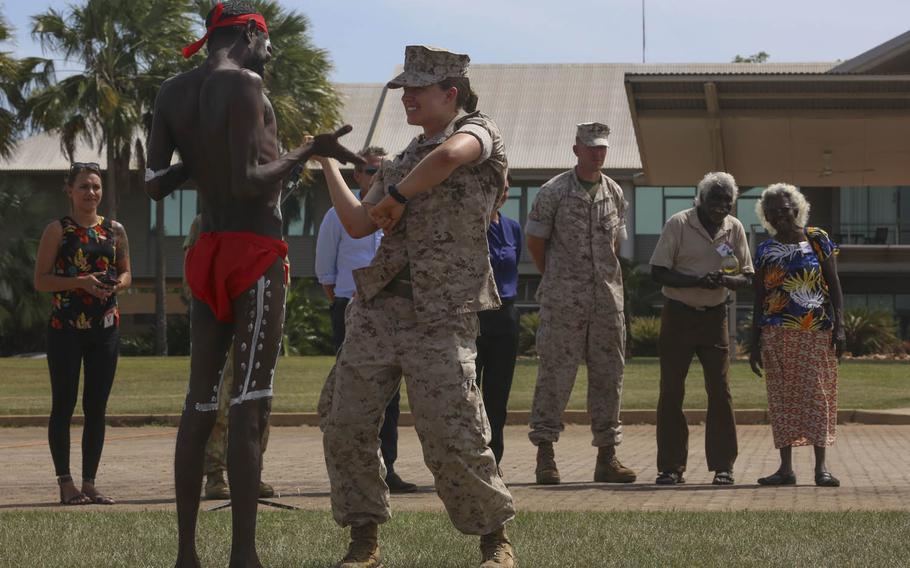
First Lt. Valerie Krygier, motor transport platoon commander, Combat Logistics Detachment 1, Marine Rotational Force-Darwin, dances with an aboriginal dancer during a welcome ceremony April 22, 2015, at Robertson Barracks, Palmerston, Australia. (Courtesy of the U.S. Marine Corps)
Eleven hundred Marines are wrapping up a six-month mission to Darwin, in Australia’s Northern Territory, and will return to the U.S. next month.
The deployment, which began in April, has involved several large exercises alongside the Australian Defence Force, said Lt. Col. Eric Dougherty, Marine Rotational Force-Darwin commander.
The Marine Corps has been deploying annually to Darwin on six-month rotations since 2012. The numbers of Marines heading Down Under has steadily increased with the goal of growing the deployment to encompass a 2,500-strong Air-Ground Task Force.
This year, Marines from 1st Battalion, 4th Marine Regiment and Combat Logistics Battalion 1 out of Camp Pendleton, Calif., worked out of Robertson Barracks while four CH-53 Sea Stallion helicopters from Hawaii’s Marine Heavy Helicopter Squadron 463 flew out of Royal Australian Air Force Base Darwin, Dougherty said.
The deployment kicked off with Predator Walk, an Australian-led exercise at Mount Bundey Training Area. Marines then joined Talisman Saber alongside 30,000 U.S. and Australian, New Zealand and Japanese troops across Australia. Marines also deployed out of Darwin for training in East Timor and Tonga. Last month, they participated in Crocodile Strike, another exercise with the Australians at Mount Bundey.
The Marines have built on lessons learned over the past six months, said Dougherty, who visited Darwin last year to prepare for the deployment.
“This year, there was much closer integration of fires and aviation assets in training,” he said, adding that cooperation with Australian forces is better than ever.
The Australians are building an amphibious force to work with new landing helicopter dock ships — the Canberra and Adelaide — that look a lot like mini-aircraft carriers. Some of the Darwin Marines are on the Canberra this week for Sea Explorer, a training exercise off the North Queensland coast, Dougherty said.
The Marines have been granted up to seven days' liberty, and some have visited bucket-list destinations such as Sydney and the Great Barrier Reef, he said.
The falling Australian dollar has made pricey activities more reasonable for the Marines, said Sgt. Edgar Celaya, 23, of Elburn, Ill., an electro-optical ordnance repairman with MRF-Darwin.
The Australian dollar, which was worth more than the U.S. dollar when the first MRF-Darwin Marines arrived in 2012, is now trading around 70 cents, with experts predicting it could drop further after a fall-off in Chinese demand for raw materials.
“Everything is pretty expensive here, so it works out about the same as in the States,” Celaya said. “It costs $15 to $20 (Australian) just for a meal.”
robson.seth@stripes.com Twitter: @SethRobson1